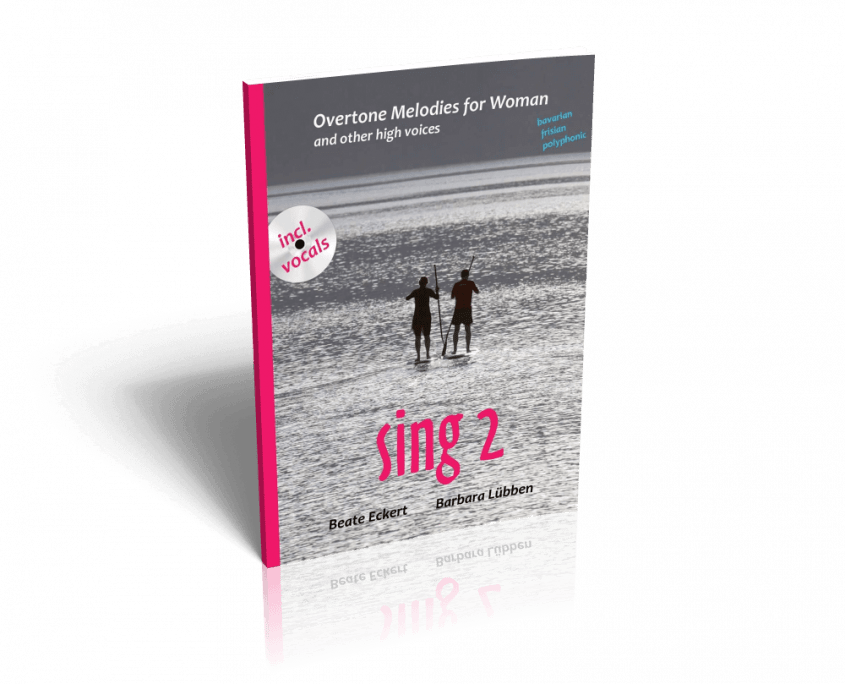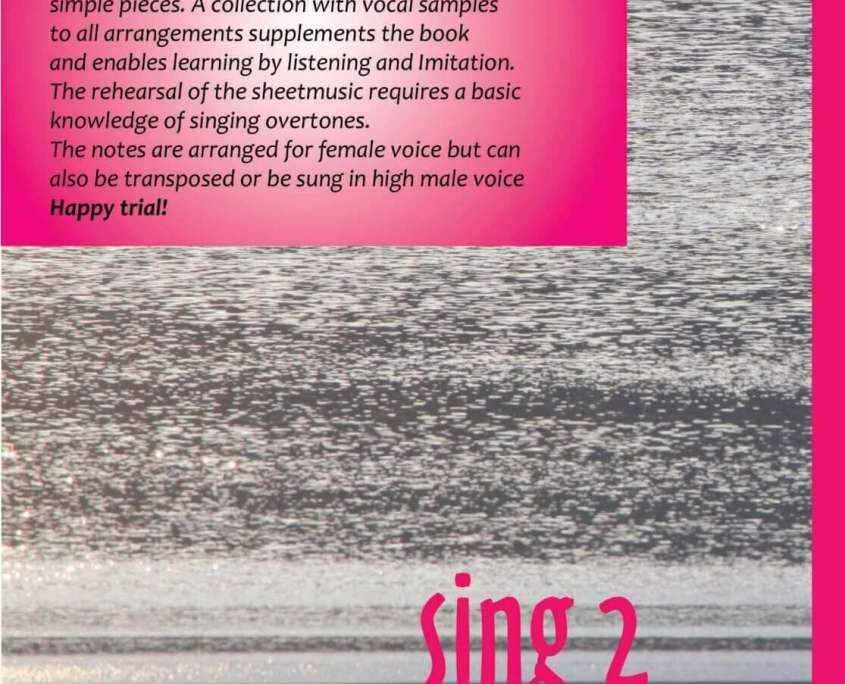In this video you will learn how to hear harmonics in vowels. This will open up a new dimension of sound perception to you. This way of hearing is rare on the fly, but it can be learned and is a prerequisite for understanding and learning choral phonetics. And it makes learning overtone singing easy and fast.
Do You Hear Syllables or a Melody?
After this video, your hearing is immediately changed, and that irreversibly. It is like a picture puzzle: once you have seen both sides, you will always see them. After the video, you are always able to hear harmonics in sounds. As soon as you have perceived both syllables and overtones, you can decide what you want to hear. And if you focus on harmonics for the next 3 weeks from today, your overtone hearing will become an integral part of your sound perception. Your brain will form new synapses.
Side Effects
You’ll be surprised what additional changes come after that:
- You will hear more empathically, understand better how other people feel, just by hearing their voice.
- When you sing in a choir, you will perceive intonation quite differently and unconsciously find a resonance with other voices.
- Many also report that they perceive colors and scents more intensely afterwards.
- You will notice a more conscious access to resonance in your voice.
If you immediately heard the melody in the first example, then you already were an overtone listener. Then the video will help you understand and become aware that you hear differently than 95% of the people around you.
But I Never Sang a Melody
One of the most exciting things about overtone listening for me is: In the end, everyone has heard the melody once, right? – but I never sang a melody! In all the singing examples, all the pitch frequencies are unchanged. I have not changed a single pitch. So in the classical sense I did not sing a melody. I only changed resonances and thus volume ratios, so in the classical sense I sang syllables on a single note, which is what most people heard at the beginning.
Despite Contradiction Everybody is Right
So if someone thought at the beginning that there was no melody, he was right, even when the melody became obvious to everyone. And everyone who hears a melody is also right. One would have to define melody independently of the tone pitch.
Many years ago, after I found out that others do not hear the same as I do, I had sent a sound file of the first example to various experts. But nobody found a melody, not even with the most modern methods of analysis. Why not? Because apparently no one thought to look for a melody. However, after hearing the melody, one finds it in the sound spectrum. But only as a volume pattern, not as a pitch change. Isn’t that exciting?
Personally, I have learned from this to approach perceptions of other people with less prejudice, especially people from the spiritual realm, who I might have dismissed as unscientific in the past. Leaving paradigms behind is probably part of the coming zeitgeist in many ways.
Find more information about the test as well as an audio version for download in my blogpost “A Melody Only Some Can Hear – Take the Hearing Test”.
Video Content
00:00 The magic of listening
00:21 Brain and sound processing
01:31 Melody hidden in syllables
01:50 Hearing test part 1 – 5% hear the melody
02:05 The melody revealed
02:58 Why some sounds remain hidden
04:02 Hearing test part 2 – 20% hear the melody
04:52 Hearing test part 3 – 40-60% hear the melody
05:20 Hearing test part 4 – 100% hear the melody
06:27 Steps to discover the melody
06:54 Step 1 – Overtone singing technique
07:03 Step 2 – Vowels between u and i
07:16 Step 3 – Consonant n
07:24 Step 4 – Consonants n and t
07:56 Step 5 – other consonants
08:32 Step 6 – Intermediate step consonant transitions
09:20 Trust your perception
09:56 Step 7 – back to syllables
10:18 Step 8 – your hearing has now been changed
Video Transcription
The most important thing in overtone singing is listening. It turns out that not everyone hears the overtones spontaneously. These are studies from the early 2000s in Heidelberg at the University Clinic, which showed that it depends on which part of the brain processes the sound. There is an auditory center on the right side that hears harmonics, and there is an auditory center on the left side that is responsible for the mathematical part of music, that is, intervals and melodies and rhythm and things like that. On the right hemisphere the timbre is analyzed, but that also includes the information of the overtones, which are usually not heard separately. And then there is an interpretation of sound as language. That happens on the left side in the Broca and Wernicke centers, which are both located on the left side. And now it’s important that when you sing overtones, that you hear the overtones. That means that you have to activate the right side, the right auditory cortex. For that, I have a test that you can use first to check where you stand, and at the end, there’s a systematic guide to the perception on the right hemisphere. So when this video is over, you’ll hear completely differently if you don’t already heared the overtones right from the first example. Now I’ll sing a meaningless sequence of syllables, and I’ll sing them on a single note, that means I won’t change any pitch, yet there’s a melody in these syllables, and I’ll hide this melody in the resonances of the vowels. Let’s see if you can hear that.
So, that was a very well-known melody from the classical period. As a little hint: It was composed in Bonn and I don’t want to hide it at all. The point is to learn to listen to it, it’s not about showing now what you can’t do, but just the opposite. It was “Joy, Beautiful Sparks of the Gods” in this register.
Typically, only 5% of people hear this melody spontaneously. If you now know what to listen for, you may now already have a little inkling of the melody or even hear it clearly. For those who don’t hear the melody now, this has nothing to do with musicality, but only with the preference on which side your brain processes this sound. There is usually a block when the left brain decides that this is speech, but it doesn’t understand a word. Then it tells the rest of the brain: Shut up, I need all the attention. And language is very dominant in our brain. That’s why this side, here the speech center, is apparently particularly active in most people. But now I would like to change this filter that says important and unimportant, language is important, timbre and overtones are unimportant. I would like to turn that around. And I do that by systematically removing information in the sound for the left side, for the speech center. I do this step by step in such a way that you will recognize at which point this flips over. At the end, you will definitely hear the melody.
Now I’ve only used Ü sounds like that, and that means in the phonetic vowel triangle I’ve only gone along vowels where the second formant, as they used to call it, or I call it “second resonant frequency”, changes. I left out all the frequencies that move in the direction of the vowel A, that would change the first resonance. So now usually there’s about 20% of the people who perceive the melody now. For the rest, I go one step further and leave out the consonants. Now usually about 40 to 60 % of the people are with me and hear this melody. If you don’t hear it yet, I go one step further.
Now everyone should have heard the melody. Who now does not hear the melody, as a whistling melody, then I unfortunately can not help. But I have never experienced that someone has not heard the melody. It can only be that one hears in such a way that it does not belong to the voice. Most people hear it as a whistling melody. And there it is separated in the brain, one then hears two separate melodies, respectively one hears a humming tone and in addition a whistling melody. For some people, this whistling melody can no longer be assigned to the voice, while others can associate this whistling tone with the voice. The main thing is that you hear this melody now.
If it has disappeared now, go back to that example where the consonants weren’t there yet, or where the consonant was N. I can fine-tune that again by replacing the T-sound with a D-sound. You’ll notices here, the more sibilants are added, the more this melody now moves into the background of awareness, and the speech center pushes itself into the foreground. But the melody is still there. Particularly interesting is the transition where you’re no longer sure, is it just my imagination, because I know what I’m supposed to hear, or did I actually hear that? And that’s a very interesting transition, because that’s where the conscious mind decides whether it trusts the right hemisphere of the brain. It’s a trust thing. You know that I’m singing the melody, so you can trust me. If you don’t trust me, then trust your own perception. If you mistrust it, then yes, you don’t know. But still the melody is there. I know that I am singing it. Next step.
Now I have added a little bit of movement into the first resonance again. And now I take a little bit more movement into it, and then I’m back at the beginning, which I started with.
And I hope that now most of you have come along up to that point. But if you have lost the melody two or three examples earlyer then it’s still perfect, then the right hemisphere is now activated. And this is an essential foundation to learn to sing harmonics.
















Recent Comment